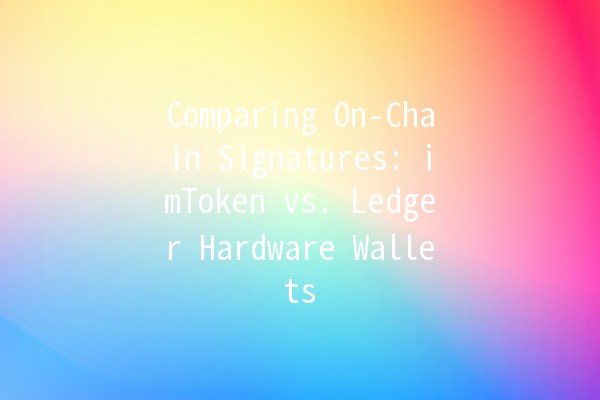In the everevolving landscape of cryptocurrencies, securing digital assets remains paramount for investors and enthusiasts alike. Two significant players in the realm of digital wallets are imToken and Ledger hardware wallets. Both offer distinct approaches to managing private keys and signing transactions onchain. This article dives deep into the comparison of onchain signatures between imToken and Ledger wallets, offering practical insights and productivityenhancing tips for users.
Before delving into the comparison, it's essential to understand what onchain signatures are. Every transaction on a blockchain requires a signature, which serves as proof that the sender has authorized the transaction. This signature is generated using the sender's private key, ensuring that only the owner can initiate and execute transactions.
Both imToken and Ledger offer unique methods for signing transactions, which can significantly influence the user experience and security.
imToken is a digital wallet designed primarily for smartphones, allowing users to manage Ethereumbased tokens and other cryptocurrencies seamlessly. It employs a secure and intuitive interface that simplifies managing assets.
UserFriendly Interface: Ideal for both novices and experienced users, making it easy to navigate through various features.

MultiCurrency Support: Users can manage multiple cryptocurrencies without the need for multiple wallets.
Secure Private Key Management: imToken’s approach to privacy ensures that users have complete control over their private keys.
Ledger is a leading brand in cryptocurrency hardware wallets, with models like Ledger Nano S and Ledger Nano X offering robust security features to store digital assets offline.
High Security: Ledger wallets are known for their advanced security measures, including secure element chips to safeguard private keys.
MultiCurrency Support: Just like imToken, Ledger supports a wide variety of cryptocurrencies.
Cold Storage Capability: Storing assets offline minimizes the risk of hacks and unauthorized access.
When using imToken, users can sign transactions directly from the mobile app. The onchain signing process typically involves the following steps:
Key Management: Users generate a crypto wallet and retain control over their private keys, which are stored locally (encrypted) on the device.
Transaction Initiation: When a user wants to send cryptocurrencies, they initiate a transaction in the app.
Signature Generation: The signing procedure takes place on the device itself, using the private key. This step ensures that the key never leaves the device.
Broadcasting Transaction: After signing, the transaction is sent to the blockchain, completing the process.
Tip for Users: Always ensure that your device's operating system is updated. Security patches regularly address vulnerabilities that could expose private keys.
In contrast, Ledger wallets offer a more secure method by keeping private keys offline:
Key Management: Private keys are stored in an isolated, secure environment (secure element), minimizing exposure to threats.
Transaction Creation: Users can generate transactions through compatible wallet software (e.g., Ledger Live) that communicates with the Ledger device.
Signing Process: Unlike imToken, the actual signing occurs on the ledger device. The private key remains securely contained within the device itself.
Approval: Users must physically confirm the transaction on the device interface (e.g., pressing a button), adding another layer of security.
Broadcasting Transaction: Once approved, the transaction is sent to the blockchain from the connected device.
Tip for Users: Whenever configuring Ledger wallets or signing transactions, only use trusted applications and connected devices.
Both imToken and Ledger offer support for multiple assets. Users can benefit significantly by consolidating assets into a single wallet for streamlined management, reducing the time spent toggling between different wallets.
Understanding and utilizing the security features of either platform can save time in the long run. For instance:
On imToken, regularly back up your recovery phrases.
With Ledger, ensure you confirm transactions at each step to avoid unauthorized actions.
Software updates often include performance improvements and security patches. Ensuring both your imToken wallet and Ledger firmware are updated allows for smoother transactions and enhanced security against vulnerabilities.
Both wallets allow users to set transaction fees based on urgency. Watching network trends can help you sign transactions when fees are lower, resulting in potential savings.
Using transaction histories available in both platforms can help identify spending habits and optimize future transactions. Users can gain insights into their crypto spending and adjust their strategies accordingly.
imToken keeps the private keys encrypted and locally stored on the user's device, while Ledger uses a secure element to store keys offline. This fundamental difference means that Ledger typically provides a higher level of security.
Both imToken and Ledger support a variety of cryptocurrencies and tokens. However, Ledger offers advanced features such as a secure chip and direct confirmation for transactions, which enhance security.
imToken is more userfriendly for mobile users, providing an intuitive interface designed for quick access. Ledger might be less intuitive initially due to its reliance on hardware and the necessity for additional setup.
Yes, both imToken and Ledger provide compatibility with various decentralized finance (DeFi) protocols. imToken users seamlessly integrate with DeFi applications via its interface, while Ledger users often do this through thirdparty wallet software.
Both wallets have strong customer support networks. However, imToken offers in